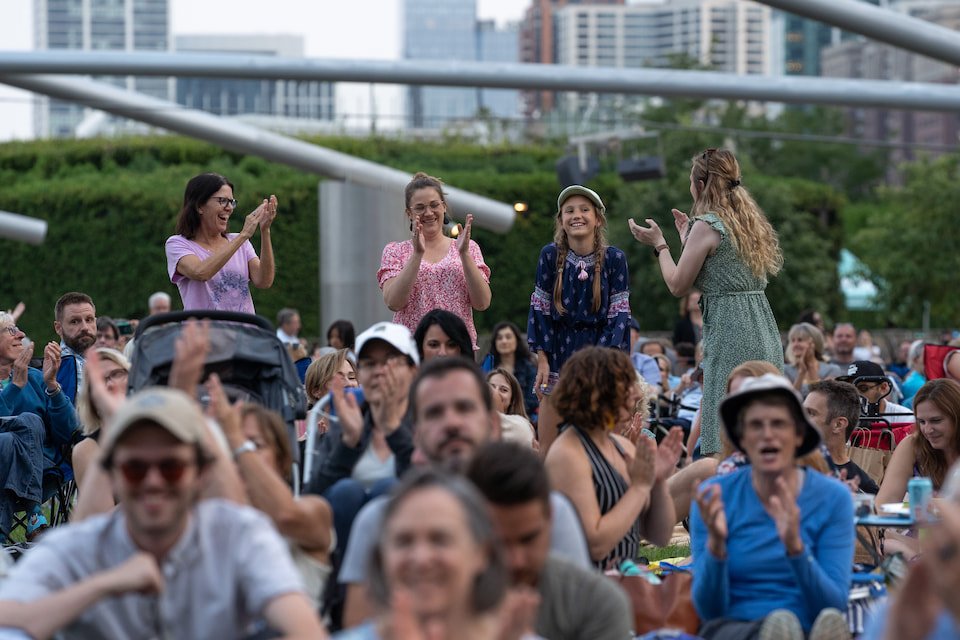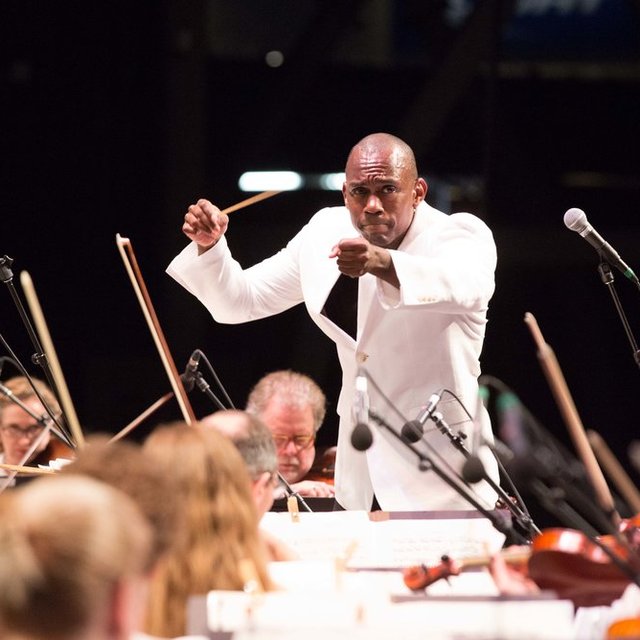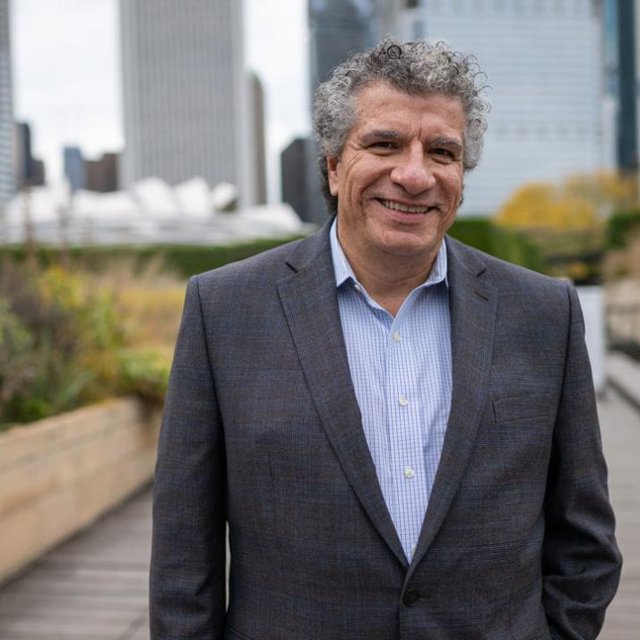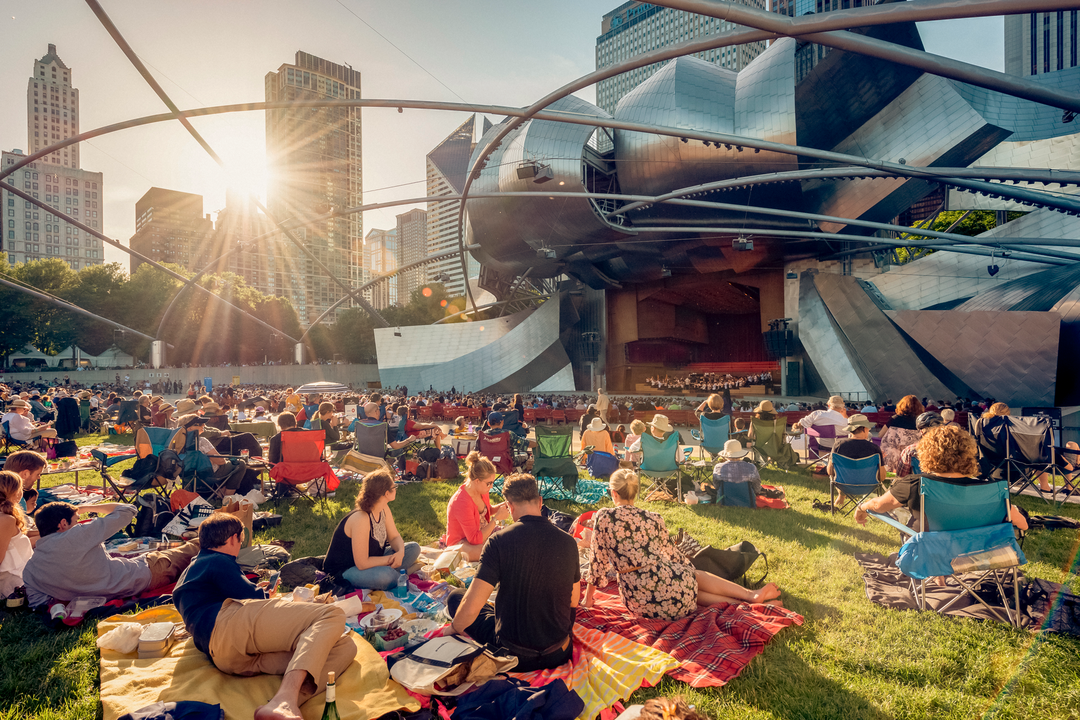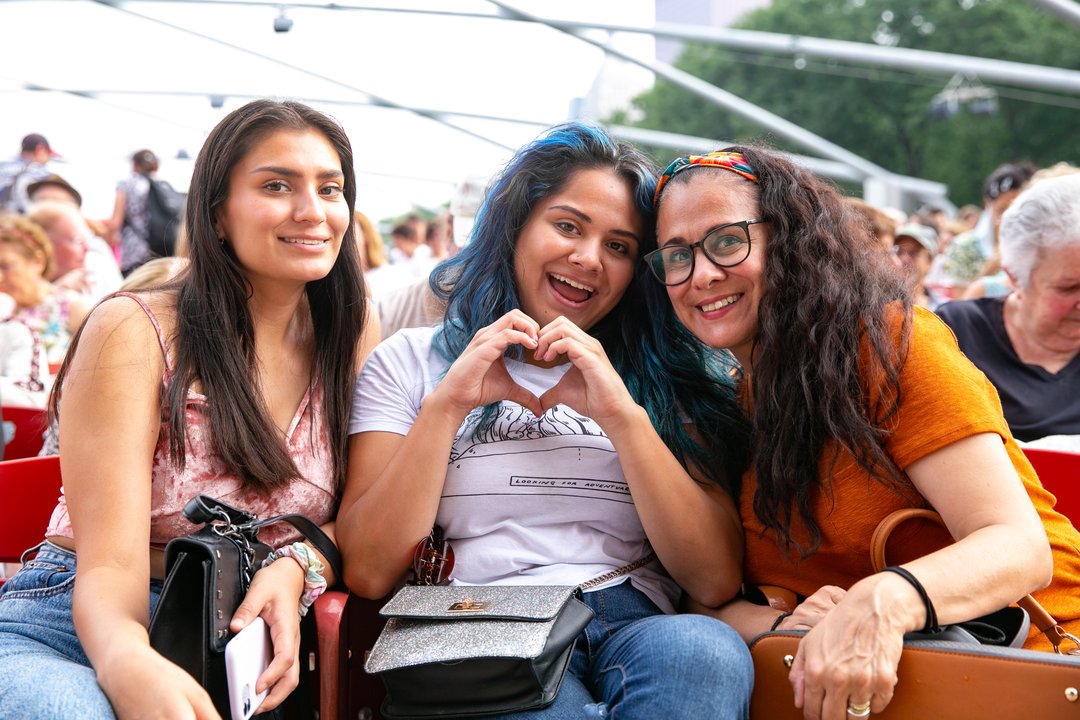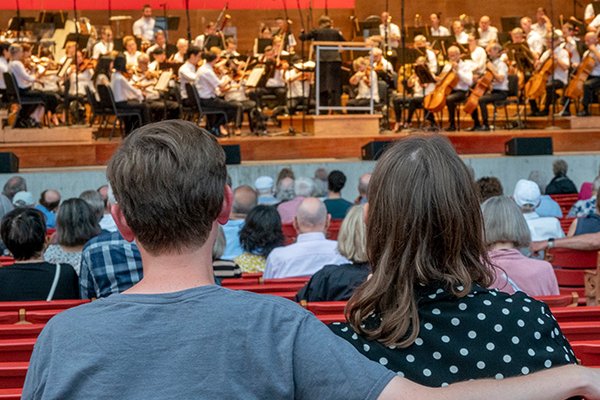
Beethoven Piano Concerto No. 4
Program
Ludwig van Beethoven Piano Concerto No. 4 (34 mins)
Allegro moderato
Andante con moto
Rondo: Vivace
Howard Hanson Symphony No. 2, Romantic (28 mins)
Adagio; Allegro moderato
Andante con tenerezza
Allegro con brio
Featuring
Program Notes
Ludwig Van Beethoven (1770–1827)
Concerto No. 4 in G major for Piano and Orchestra, op. 58 (1805)
Scored for: one flute, two oboes, two clarinets, two bassoons, two French horns, two trumpets, timpani, strings, and solo piano
Performance time: 34 minutes
First Grant Park Orchestra performance: June 27, 1958; Joseph Rosenstock, conductor and Jorge Bolet, piano
December 22, 1808—the date of one of the most legendary performances in classical music history. That night in the frigid Theater an der Wien, Ludwig van Beethoven mounted a four-hour concert of mostly new music. The program included premieres of his Fifth and Sixth Symphonies, his Choral Fantasy, movements from his Mass in C, and his Fourth Piano Concerto, which he conducted from the piano. While reactions to the symphonies were tepid, one reviewer had this to say about the concerto: “A new concerto for pianoforte, terribly difficult, which Beethoven performed astonishingly well in the fastest possible tempi. The [Andante], a masterpiece of beautiful sustained melody, he actually sang on his instrument with a deep melancholy feeling which awakened its response in me.” This concert would be Beethoven’s last public piano performance, as his worsening deafness made collaborative music-making increasingly difficult.
Beethoven’s Piano Concerto No. 4 is remarkable for several reasons, both for its emphasis on finesse and expression over soloistic bravura and for its structural peculiarities. According to convention, the orchestra introduces the main themes of the first movement in a classical concerto. The soloist eventually joins in, and the two parties generally take turns. Instead, Beethoven makes a quietly revolutionary choice by beginning his concerto with the piano alone. The only precedent for this was Mozart’s Piano Concerto No. 9, where the soloist enters in the second bar, interrupting the orchestra’s opening statement. But to begin with just the piano, playing music of arresting delicacy, would have shocked audiences at the time.
The piano soloist’s dolce introduction in G major casts a dreamy mood over the entire concerto. When the orchestra enters five bars later, it responds pianissimo and in the surprising key of B major. Beethoven continues to thwart expectations, as the soloist does not reenter where it sounds like it should. Instead, the orchestra continues to elaborate on the three-note upbeat figure of the opening statement across different keys and introduces a second theme before the soloist eventually reenters. The interplay between the soloist and the orchestra proceeds as expected for a while. However, Beethoven repeatedly pulls back the curtain to reveal the dreamland of the opening five bars with pianissimo passages in unexpected keys.
The Andante con moto is one of the most discussed movements in all of Beethoven’s output. Scholars have long debated whether it depicts the Greek myth of Orpheus and Eurydice. In the story, Orpheus attempts to rescue his wife, Eurydice, from the underworld. He uses the power of music to placate the Furies and the three-headed dog, Cerberus, who guard the entrance to Hades. Adolph Bernhard Marx, an early Beethoven biographer, argues that Beethoven was referencing Gluck’s 1762 opera Orfeo ed Euridice, a work Beethoven knew well. Several other operas on the Orpheus myth were in circulation at the time as well, which Beethoven would have been aware of. In addition, Ovid’s Metamorphoses, one of two main classical sources of the Orpheus legend alongside Virgil’s Georgics, was experiencing a surge in popularity. Although published throughout Europe for centuries, Metamorphoses was only published in Vienna for the first time in 1791, having previously been censored.
Considering this cultural craze for Orpheus, it would not be surprising if Beethoven had been influenced by the Greek myth. Although Beethoven never said the Andante was programmatic, it is easy to hear the influence of opera in the recitative-like dialogue between the austere orchestra and pleading piano. What’s more, the pianist’s cadenza—full of trills, chromatic scales, and rolled arpeggios—might be interpreted as Orpheus lulling Cerberus to sleep with his lyre.
Beethoven ends the concerto on a playful note with the rondo-form finale. The orchestra and piano engage in witty repartee, back on friendly terms after the drama of the inner movement. Although trumpets and drums finally emerge in the finale, the overall tone is light rather than heroic, featuring dream-like passages reminiscent of the first movement.
Howard Hanson (1896–1981)
Symphony No. 2, Romantic, op. 30 (1930)
Scored for: three flutes including piccolo, three oboes including English Horn, two clarinets, three bassoons including contrabassoon, four French horns, three trumpets, three trombones, tuba, timpani, percussion, harp, and strings
Performance time: 28 minutes
First Grant Park Orchestra performance: July 8, 1972; Skitch Henderson, conductor
While he might not have the same level of name recognition as other 20th-century American composers like Aaron Copland and Leonard Bernstein, Howard Hanson had such a profound influence on American classical music that he was dubbed the “Dean of American Composers” and “spokesman for music in America.” A graduate of Northwestern University in 1916, Hanson went on to become the first American composer to win the prestigious Prix de Rome in 1921. After studying in Italy for three years with Ottorino Respighi, Hanson returned to the United States, where he was soon offered the directorship of the newly established Eastman School of Music in Rochester, New York. He accepted the position shortly before his 28th birthday and would serve as the school’s director until 1964. He dedicated much of his career, both as an educator and conductor, to promoting and disseminating American contemporary music through performance, recording, and publishing.
Hanson had a successful career as a composer as well, and his music was performed widely during his lifetime. He won the Pulitzer Prize in 1944, and his only opera, Merry Mount (1934), was commissioned by the Metropolitan Opera at a time when the performance of new American operas was even rarer than it is today. However, Hanson’s musical conservatism caused his works to wane in popularity in the late 20th century. In an effort to create an “American” sound apart from trends in Europe, he favored traditional harmonies and melodies over dissonance and experimentation. His neo-Romantic approach is nowhere more apparent than in his lushly scored and melodically appealing Symphony No. 2, “Romantic.”
Hanson’s “Romantic” Symphony is cyclic, meaning musical motifs recur throughout each of the three movements, creating a sense of unity and cohesion. The first movement begins with an atmospheric woodwind introduction featuring an ascending three-note figure that builds with each repetition and instrumental addition. Next, a horn fanfare heralds the second theme, a syncopated descending melody that will become the overarching motto of the whole symphony. The English horn contrasts this theme with a more tender melody. Lyrical and declamatory episodes alternate throughout the rest of the movement in a cinematic journey full of longing, nostalgia, and occasional heroics.
The second movement, marked Andante con tenerezza (“with tenderness”), again opens with the woodwinds, this time playing a gentle hymn-like melody over lush string accompaniment and plangent horns. Themes from the first movement recur, alternated with elaborations on the Andante’s opening hymn. The Allegro con brio opens with a flurry of activity in the woodwinds and strings, answered by a majestic horn call. If this reminds you of a Hollywood score, it might be because John Williams modeled his music for the bike chase scene in E.T. (1982) on this movement. Director Ridley Scott also recognized the cinematic potential in Hanson’s symphony, using the end of the first movement to accompany the end credits of his 1979 sci-fi thriller, Alien.
—Katherine Buzard
Artistic Leadership
Support The Festival
Violin I
Jeremy Black, concertmaster
Vacant, assistant concertmaster
Trista Wong
Zulfiya Bashirova
Jennifer Cappelli
Injoo Choi
Dima Dimitrova
Erica Hudson
Hyewon Kim
Matthew Lehmann
Jayna Park
Rika Seko
Karen Sinclair
Bonnie Terry
Krzysztof Zimowski
Violin II
Liba Shacht, principal
Vacant, assistant principal
Ying Chai
Ran Cheng
Karl Davies
Likai He
Ann Lehmann
Laura Miller
Cristina Muresan
Kjersti Nostbakken
Irene Radetzky
Jeanine Wynton
Thomas Yang
Viola
Terri Van Valkinburgh, principal
Yoshihiko Nakano, assistant principal
Elizabeth Breslin
Beatrice Chen
Amy Hess
Rebecca Swan
Chloé Thominet
Cello
Walter Haman, principal
Peter Szczepanek, assistant principal
Calum Cook
Larry Glazier
Steven Houser
Eric Kutz
Eran Meir
Double Bass
Colin Corner, principal
Peter Hatch, assistant principal
Andrew Anderson
Christian Luevano
Samuel Rocklin
Chunyang Wang
Chris White
Flute
Vacant, principal
Alyce Johnson
Jennifer Lawson, assistant principal
Piccolo
Jennifer Lawson
Oboe
Mitchell Kuhn, principal
Vacant
Anne Bach, assistant principal
English Horn
Anne Bach
Clarinet
Dario Brignoli, principal
Trevor O’Riordan, assistant principal
Besnik Abrashi
Bass Clarinet
Besnik Abrashi
Bassoon
Eric Hall, principal
Nicole Haywood Vera Tenorio, assistant principal
Vacant
Contrabassoon
Vacant
Horn
Vacant, principal
Stephanie Blaha, assistant principal
Neil Kimel
Brett Hodge
Paul Clifton
Trumpet
David Gordon, principal
Mike Brozick
Vacant, assistant principal
Vacant
Trombone
Daniel Cloutier, principal
Jeremy Moeller, assistant principal
Bass Trombone
Alexander Mullins
Tuba
Andrew Smith, principal
Timpani
Daniel Karas, principal
Josh Jones, assistant principal
Percussion
Josh Jones, principal
Vacant, assistant principal
Doug Waddell
Harp
Kayo Ishimaru-Fleisher, principal
Keyboards
Christopher Guzman
Orchestra Librarian
Eliza Bangert, principal
Grant Park Chorus
* denotes leave-of-absence † 2025 Vocal Fellow
Laura Lynch Anderson
Kristina Bachrach
Madalynn Baez
Megan E. Bell
Alyssa Bennett
Tamara Bodnar
Kylie Buckham
Anna Joy Buegel
Laura Bumgardner
Katherine Buzard
Bethany Clearfield
Nathalie Colas
Carolyne DalMonte
Megan Fletcher
Kaitlin Foley
Saira Frank
Julia Frodyma
Katherine Gray-Noon
Kimberly Gunderson
Alexandra Ioan
Alexandra Kassouf
Darlene Kelsey
Olivia Knutsen
Marybeth Kurnat
Katelyn Lee
Kyuyim Lee+
Rosalind Lee
Veronica Mak
Hannah Dixon McConnell
Marie McManama
Kathleen Monson
Susan Nelson
Evangeline Ng
Máire O'Brien
Alexandra Olsavsky
Laura Perkett
Angela Presutti Korbitz
Alexia Rivera
Veronica Samiec
Emily Sinclair
Molly Snodgrass
Tiana Sorenson
Christine Steyer
Sarah van der Ploeg*
Lydia Walsh-Rock
Sherry Watkins
Emily Amesquita
Melissa Arning
Christina Bernardoni
Angela Born
Bethany Brewer
Julie DeBoer
Leah Dexter
Katrina Dubbs
Stacy Eckert
Margaret Fox
Catarine Hancock
Ruth Ginelle Heald
Sophia Heinz
Miya Higashiyama
Carla Janzen
Amy Allyssa Johnson
Kathryn Kinjo Duncan
Amanda Koopman
Anna Laurenzo
Jeannette Lee
Thereza Lituma
Chelsea Lyons
Victoria Marshall
Jessica McCarthy
Quinn Middleman
Ella Peters
Sarah Ponder
Emily Price
Stephanie Schoenhofer
Suzanne A. Shields
Marissa Simmons
Cassidy Smith
Aidan Spencer
Alannah Spencer
Margaret Stoltz
Carolyn Sundlof Boudreau
Gabrielle Timofeeva López
Elizabeth Vaughan
Corinne Wallace-Crane
A.J. Wester
Debra Wilder
Isabel Yang+
Charles Anderson
Enrico Giuseppe Bellomo
Justin Berkowitz
Madison Bolt
Hoss Brock
Steven Caldicott Wilson
Opal Clyburn-Miller+
John J. Concepción
Micah Dingler
Jared V. Esguerra
Alec Fore
Ace Gangoso
Klaus Georg
Tejas Gururaja
Paul Hunter
Garrett Johannsen
William Johnson
James Judd
Tim Lambert
Tyler Lee
Stephen D. Noon
Marcos Ochoa
Brett Potts
Nicholas Pulikowski
Peder Reiff
Samuel Rosner
Matthew W. Schlesinger
Joe Shadday
Aaron Short
Brian Skoog
Michael St. Peter
Ryan Townsend Strand
Alan Taylor*
Sean J. Watland
Nate Widelitz
Walter Aldrich
Evan Bravos
Matthew Brennan
Michael Cavalieri
Ryan J. Cox
Ed Frazier Davis
Lifan Deng
Matthew Dexter+
Chris DiMarco
Christopher Filipowicz
Dimitri German
Dominic German
David Govertsen
Spencer Greene
Brian Hupp
Jan Jarvis
Jess Koehn
Eric Miranda
Ian Morris
Ian Murrell
John E. Orduña
Wilbur Pauley
Douglas Peters
Jackson Pierzina
Martin Lowen Poock
Ian Prichard
Dan Richardson
Stephen Richardson
Benjamin D. Rivera
Scott Uddenberg
Schyler Vargas
Vince Wallace
Aaron Wardell
Ronald Watkins
Jonathon Weller
Peter Wesoloski
Jonathan Wilson
Chuck Foster
John Goodwin
Kyuyim Lee
Isabel Yang
Opal Clyburn-Miller
Matthew Dexter
